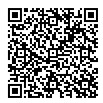2D barcodes link Linux devices to online info
Mar 29, 2007 — by LinuxDevices Staff — from the LinuxDevices Archive — 3 views 3GVision is bringing the U.S. a 2D barcode protocol that has achieved widespread use in Japan as an instant link to online data. The company's i-nigma 2D barcode scanning system works on camera-equipped devices running Linux/Java, Windows Mobile, BREW, or Symbian.
3GVision is bringing the U.S. a 2D barcode protocol that has achieved widespread use in Japan as an instant link to online data. The company's i-nigma 2D barcode scanning system works on camera-equipped devices running Linux/Java, Windows Mobile, BREW, or Symbian.
In Japan, according to 3GVision, QR (quick response) codes (shown above) serve as hyperlinks to more information about products and services carrying the black-and-white square codes. A mobile phone camera scans the QR code label and returns the web page pointed to by the contents of the label. More than half of Japanese report that they regularly scan QR codes using mobile phones to direct-connect to the mobile Internet, the company says.
3GVision claims its code-reading software is embedded in over 50 million Japanese handsets — representing over 100 handset models — and has become the “de-facto industry standard” for Japanese wireless carriers and handset vendors. The company is now offering the i-nigma reader as part of a full service package, “tailored to the needs of key stakeholders in the mobile code ecosystem: wireless operators, handset manufacturers, media companies, advertisers and their agencies, mobile content and service providers.”

Example of a QR Code on an advertisement
QR Code technology was originally developed by Denso Wave as a means for storing more information than a conventional barcode. A QR Code can hold just over 7,000 numeric-only characters, or over 4,000 alphanumeric characters. Having been developed in Japan, QR Code can also encode Kanji and Kana character sets.
Codes can be printed on any physical object, including advertisements, billboards, packaging, currency, and garments. Being 2-dimensional, the code can be quickly read from any orientation and it has built-in data correction capability, according to Denso Wave.
 A similar system using a circular “ShotCode” was announced nearly two years ago by OP3 AB. At the time, the ShotCode client application only ran on a dozen of so Nokia and Siemens cameraphones. OP3 now claims 154 compatible models, some of which appear to be Linux devices.
A similar system using a circular “ShotCode” was announced nearly two years ago by OP3 AB. At the time, the ShotCode client application only ran on a dozen of so Nokia and Siemens cameraphones. OP3 now claims 154 compatible models, some of which appear to be Linux devices.
3GVision CEO Mendy Mendelsohn stated, “Having made the necessary adaptations to our solution for the global market, we are experiencing a very high level of interest from operators, media,m and advertising agencies and their clients in Europe especially — a strong indication to us that the worldwide take-up will match our experience in Japan.”
This article was originally published on LinuxDevices.com and has been donated to the open source community by QuinStreet Inc. Please visit LinuxToday.com for up-to-date news and articles about Linux and open source.